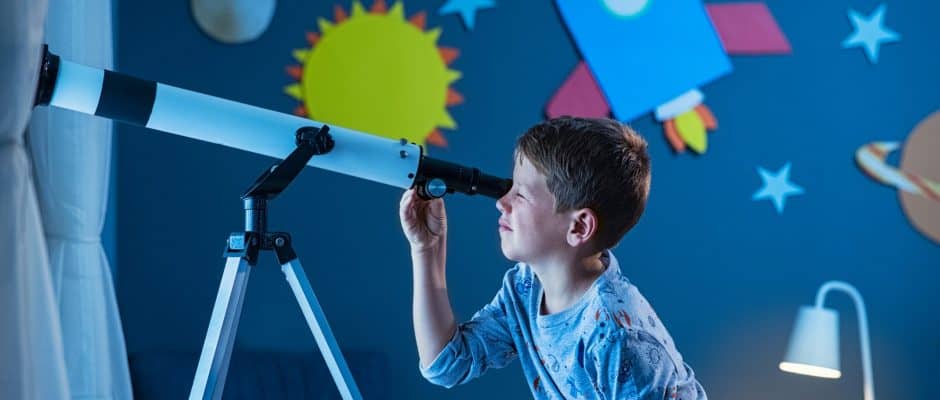
Love the night sky? Use simple materials to make a telescope then look into the sky and discover the stars.
You will need
- Tables
- Chairs
- Pens or pencils
- Rulers
- Something to protect surfaces (for example, newspaper or tablecloths)
- Craft materials (for example, tissue paper, pipe cleaners, stickers)
- Scissors
- PVA glue
- Cardboard tubes
- Paint brushes
- 1cm wide concave lenses
- 1.5cm wide convex lenses
- Craft knives
- Sheets of cardboard
- Black electrical tape
- Black paint
Get into position
- Everyone should find their own seat. The person leading the activity should remind everyone that the seats (and piles of equipment) have been set out so everyone will be safe.
- The person leading the activity should explain that the night sky is full of different things, from stars and planets to satellites. There’s a limit to what the naked eye can see (and elements such as lights from a town or city can also limit what the eye can see). People use telescopes to be able to see more.
Make a telescope
- Draw two parallel lines from the top of one of the tubes to the bottom. The lines should be one centimetre apart.
- Use scissors to cut along the lines and remove a strip of the tube.
- Put the tube with the strip missing into the other tube. Squeeze the tube with the strip missing together slightly to make it fit, then check that it moves up and down the inside of the tube without catching on anything. If the inner tube catches and won’t slide freely, cut another (thin) strip from it and then try again. Be careful to keep the inside of the telescope as dark as possible.
- Once the inner tube’s a perfect fit, tape it back together with black tape then try the sliding action again. Try to place the tape evenly on the inside of the inner tube so it keeps its shape and doesn’t catch in the outer tube.
- Place the smaller, taped tube on a sheet of card and draw around the end with a pen or pencil.
- Use a ruler to draw a cross in the circle.
- Put the one centimetre concave lens in the centre of the circle and draw around it.
- Cut the larger circle out then use a craft knife to carefully cut out the smaller circle from the centre. An adult should supervise everyone from a safe distance as they do this.
- Brush some glue around the edges of the small hole in the circle.
- Find the flat side of the one centimetre concave lens. Push the lens into the hole so that it sticks there with the flat side facing up. Wipe away any excess glue.
- Brush some glue around the edges of one end of the smaller, taped tube.
- Push the circle of card with the concave lens into the tube so that it sticks with the flat side facing up. Leave it to dry with the lens facing down so the lens can’t drop out and break.
- Once the glue’s dried, carefully tape over any joins with the black tape to keep any light out.
- Brush some glue around the edges of one end of the other tube. Take the one and a half inch lens and gently push it into the tube so that it sticks. Wipe away any excess glue. Again, leave this to dry with the lens facing down so the lens can’t drop out and break.
- Once the glue’s dried, decorate the telescope. You could use paint, pens, stickers, or other craft materials. It’s up to you what you use and what design you’ll aim for. You could make them look like real life telescopes with complicated dials and panels or come up with a new telescope design. It may depend on how much time you have.
Discover the stars
- Everyone should take the telescopes outside and find a space two metres apart from everyone else.
- Everyone should look through their telescope and see which stars they can find.
- The person leading the activity could challenge everyone to find specific things like constellations, satellites, or the North Star. Make sure you can see anything you’re challenging people to find.
Reflection
The sky we see at night is full of different things, from stars and planets to satellites and asteroid showers. To be able to see more, people and astronomers use telescopes of all different sizes. How did your team work together to make a telescope to help you look at the stars? You needed a delicate touch to glue in the lenses and shape the inner tube, and a creative approach to come up with a design.
The naked eye has a limit to what it can see. But also, depending on where you live, other elements can reduce what you’re able to see, such as urban lights. How does your telescope help you see more? What could you change about your telescope to see even further? Think about other lenses and materials you could use.
Courtesy of Scouts UK.

 English
English